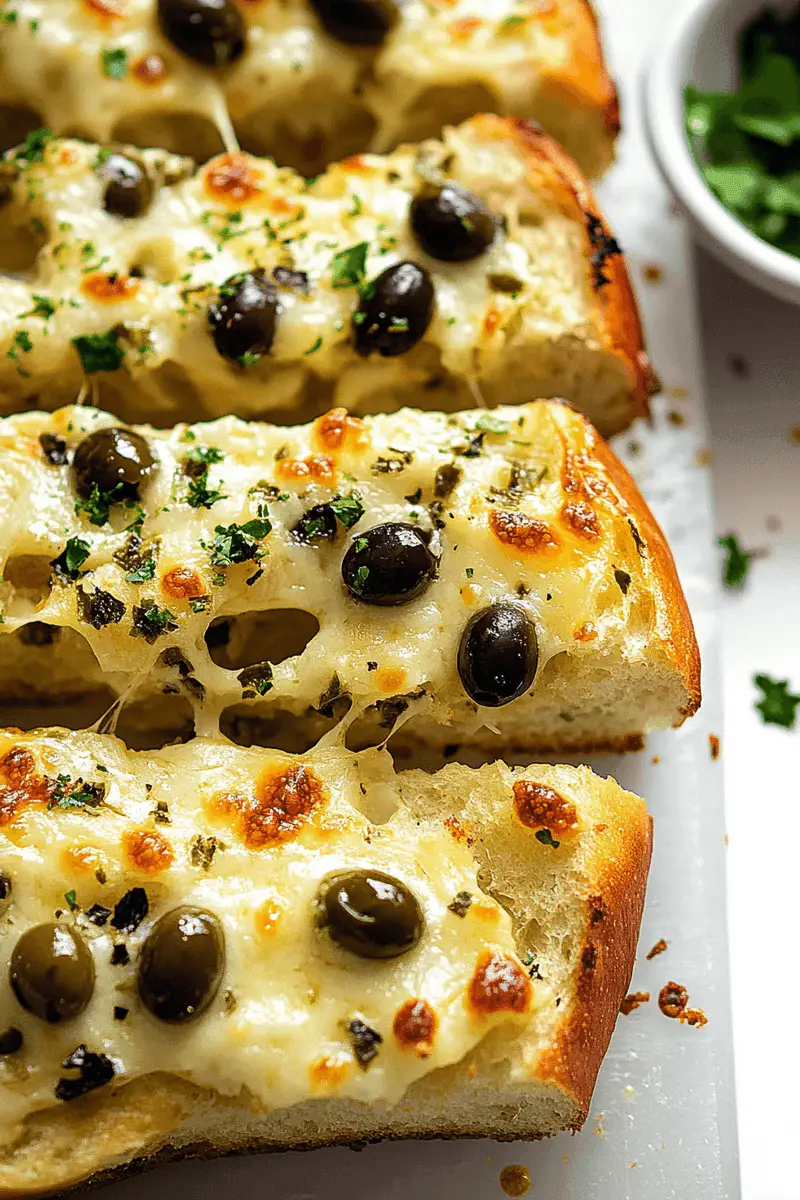Introduction
If you’re looking for a delicious and savory treat to elevate your meal or serve as a snack, this olive cheese bread recipe is the answer. Imagine biting into warm, freshly baked bread infused with rich cheese and briny olives. It’s a delightful combination that satisfies both the savory cravings and the comfort of homemade baking. This easy recipe is perfect for gatherings, picnics, or even just a cozy night in.
The beauty of this dish lies not just in its taste but also in how simple it is to prepare. With minimal ingredients and straightforward steps, you can whip up a batch of this irresistible olive cheese bread without any fuss. Whether you’re an experienced baker or a kitchen novice, this recipe will guide you through every step of the process.
As we dive deeper into this culinary adventure, you’ll learn about the essential ingredients that make this dish stand out. Plus, I’ll provide you with tips on serving and storing your delicious creation so that it remains fresh and flavorful for days to come. Get ready to impress your family and friends with this delightful addition to your recipe collection!
What You’ll Need
To create the perfect olive cheese bread, you’ll need some basic ingredients that are likely already in your pantry. The process is uncomplicated but yields impressive results that everyone will love. Here’s what you need:
First off, gather high-quality all-purpose flour; it’s the foundation of our bread. Next up is yeast—active dry yeast works best here to give your loaf that lovely rise. You’ll also want to have shredded cheese on hand; sharp cheddar or mozzarella are excellent choices for their melting qualities and flavor.
Don’t forget about olives! Kalamata or green olives add that signature salty kick that complements the richness of the cheese beautifully. Finally, having essentials like salt and water will round out our ingredient list.
Now let’s break down these components further in the next section so you understand why each one plays a vital role in achieving perfectly baked olive cheese bread!
Ingredients with precise measurements
- All-purpose flour (3 cups)
All-purpose flour serves as the main structure of our bread. It provides gluten necessary for elasticity while keeping the texture light and airy. Choose unbleached flour if possible for a more natural flavor.
- Active dry yeast (2 teaspoons)
Yeast is crucial for fermentation; it helps our dough rise beautifully during baking. Ensure your yeast is fresh by checking its expiration date before using it.
- Warm water (1 cup)
Warm water activates the yeast when mixed with flour. The ideal temperature should be around 100°F to 110°F—too hot can kill the yeast while too cold won’t activate it properly.
- Shredded cheese (1 cup)
Cheese adds flavor and moisture to our loaf. A blend of sharp cheddar and mozzarella creates a delightful gooey texture as it melts during baking.
- Olives (1 cup)
Chopped olives infuse salty bursts of flavor throughout the loaf. Choose pitted kalamata or green olives based on preference; both work well.
- Salt (1 teaspoon)
Salt enhances all flavors in our bread while controlling yeast activity during fermentation—don’t skip this essential ingredient!
Now that we’ve covered what you need to create this mouthwatering olive cheese bread recipe let’s move on to how to make it effortlessly!
How to Make Olive Cheese Bread Recipe
1. Prepare Your Dough: Start by mixing warm water with active dry yeast in a large mixing bowl. Allow it to sit for about five minutes until frothy; this indicates that your yeast is activated. Gradually add three cups of all-purpose flour along with one teaspoon of salt into the bowl while stirring until combined into a shaggy dough.
2. Kneading: Transfer your dough onto a floured surface and knead it for about ten minutes until it’s smooth and elastic. If needed, sprinkle small amounts of extra flour as you knead but avoid adding too much—the dough should remain slightly tacky but manageable.
3. Incorporating Ingredients: Once kneaded adequately, fold in shredded cheese and chopped olives evenly across the dough surface before continuing to knead gently just long enough to distribute them throughout without overworking it.
4. First Rise: Place your dough ball into an oiled bowl—turning it once ensures all sides are coated—and cover with plastic wrap or a damp towel. Let it rise in a warm area until doubled in size; usually around one hour works best depending on room temperature conditions.
5. Shaping & Second Rise: After rising sufficiently, punch down your dough gently to release air bubbles formed during fermentation before shaping into desired loaf form or placing into greased loaf pans if preferred! Letting shaped loaves rise again covered lightly allows them time to increase volume—about thirty minutes should suffice here.
6. Baking Time: Preheat your oven at 375°F (190°C) while waiting for second rise completion! Once ready bake loaves directly placed onto baking sheets lined with parchment paper until golden brown—approximately thirty-five minutes should yield crispy crusts paired alongside soft interiors bursting with cheesy goodness!

Serving and Storing Tips
Serving Suggestions
Olive cheese bread can be enjoyed warm right out of the oven or at room temperature—it pairs beautifully with soups or salads! For an elegant appetizer option slice thinly alongside charcuterie boards featuring cured meats & cheeses complemented by assorted dips such as hummus or tapenade! Additionally consider pairing slices toasted lightly drizzled with balsamic glaze/olive oil providing enhanced flavors elevating any meal occasion effortlessly!
Storage Guidelines
To store leftover olive cheese bread effectively allow cooling completely before wrapping tightly using plastic wrap/foil preserving moisture levels within preventing staleness over time! This way they stay fresh up-to four days stored within room temperature environments avoiding refrigeration which could alter texture negatively instead opt freezing portions if longer shelf-life desired—instructions include slicing first then sealing within freezer bags ensuring air removed prior freezing lasting several months when stored appropriately!
By following these simple serving and storage tips along with our detailed instructions above creating delicious homemade olive cheese bread becomes not only achievable but enjoyable too! So roll up those sleeves get started today delighting taste buds everywhere satisfied by scrumptious bites ahead!
Mistakes to avoid
One common mistake when making an olive cheese bread recipe is using stale bread. Freshness is key to achieving the right texture and flavor. Stale bread can result in a dry and unappetizing loaf. Always opt for fresh, high-quality bread that will absorb the flavors of the olives and cheese beautifully.
Another mistake involves not measuring ingredients accurately. A successful olive cheese bread recipe relies on precise measurements for both liquid and dry ingredients. Too much or too little of any component can alter the outcome significantly. Invest in a good kitchen scale and measuring cups to ensure your ingredients are measured correctly.
Overmixing the dough is another pitfall to avoid. While it may be tempting to mix until everything is perfectly combined, overmixing can lead to a dense texture instead of a light and fluffy bread. Mix just until the ingredients are incorporated, allowing the dough to retain some airiness.
Failing to let the dough rise properly also affects the final product. Rising allows yeast to work its magic, developing flavor and texture. Skipping this step may give you a flat loaf lacking in taste and fluffiness. Follow your olive cheese bread recipe closely regarding rising times, ensuring you have ample time for fermentation.
Finally, many home bakers neglect oven temperature accuracy. An incorrectly preheated oven can result in uneven baking or burnt crusts. Use an oven thermometer if necessary, particularly when following a precise olive cheese bread recipe, to ensure proper temperature control.

Tips and tricks
To perfect your olive cheese bread recipe, start with high-quality olives. Choose between green or black olives based on your personal preference; however, pitted olives are essential for convenience and safety while eating. You may also consider marinated olives for added flavor complexity.
Incorporating different types of cheeses can elevate your bread’s flavor profile significantly. A mixture of sharp cheddar, creamy mozzarella, or even tangy feta can create a delightful blend that complements the olives wonderfully. Experiment with various cheeses until you find your perfect combination that aligns with your taste preferences.
Using herbs such as oregano or thyme in your olive cheese bread recipe can enhance its flavor even further. Fresh herbs provide a vibrant aroma and taste that pairs well with the savory elements of the dish. If using dried herbs, ensure they are fresh for potent flavor contributions.
Pay attention to baking time as well; underbaking can lead to doughy centers while overbaking results in dryness. It’s crucial to keep an eye on your loaf as it nears completion, checking for that golden-brown crust while ensuring it cooks through properly.
Lastly, allowing your olive cheese bread to cool before slicing is essential for optimal texture and flavor development. As tempting as it may be to dig right in, giving it about 10-15 minutes will help set the crumb structure while enhancing overall enjoyment during consumption.
Suggestions for olive cheese bread recipe
When preparing your olive cheese bread recipe, consider adding some sun-dried tomatoes or roasted garlic for extra flavor depth. These ingredients blend beautifully with olives and cheese while introducing new textures into each bite.
If you’re looking for a gluten-free option, swap regular flour with almond flour or gluten-free all-purpose flour blends available at most grocery stores today. While the texture might differ slightly from traditional recipes, you’ll still achieve a deliciously satisfying loaf that everyone can enjoy.
Serving suggestions play an important role too; pair freshly baked olive cheese bread with dips like hummus or tzatziki for a delightful appetizer platter during gatherings or casual get-togethers with friends and family.
For those who prefer a lighter version of this dish, consider using low-fat cream cheese instead of full-fat varieties without sacrificing creaminess entirely! This small swap not only cuts calories but still delivers great taste throughout every slice enjoyed by guests at any occasion!
Lastly, try wrapping leftover slices tightly in plastic wrap or aluminum foil before storing them in an airtight container so they remain fresh longer! This method helps preserve moisture content while preventing freezer burn if stored away for later use—making future meals just as enjoyable!
FAQs
How long does it take to prepare an olive cheese bread recipe?
Preparation time for an olive cheese bread recipe typically takes around 20 minutes if you have all your ingredients ready beforehand. This includes chopping olives and measuring out other components such as flour and yeast accurately. After preparation comes resting time which usually lasts about an hour depending on room temperature conditions aiding yeast activation—so plan accordingly! Baking itself usually requires 30-40 minutes until golden brown perfection emerges from the oven! Thus overall timing could range between one-and-a-half hours up to two hours inclusive of both preparation plus baking stages combined!
Can I use different types of flour in this recipe?
Absolutely! While all-purpose flour works best traditionally within an olive cheese bread recipe base due its versatility; whole wheat flour adds nutritional benefits along with nuttier flavors if desired! Additionally gluten-free alternatives exist now too such as almond meal or coconut-based flours available commercially catering specifically towards dietary restrictions—but note adjustments must occur regarding liquid ratios since these substitutes behave differently than standard flours do during baking processes!
What kind of olives should I use?
Choosing between green or black olives largely depends on personal preference! Green olives tend to offer more briny notes whereas black varieties provide sweetness alongside richness—both complimenting cheesy bases effectively well within recipes! Pitted options simplify food prep greatly preventing potential choking hazards whilst enjoying finished products later on—making life easier overall both cooking & eating times alike!
How do I store leftover olive cheese bread?
To maintain freshness after preparing an enticing loaf; allow cooling down completely first prior wrapping tightly either using plastic wrap directly over slices themselves—or alternatively aluminum foil encasing whole loaves preserving moisture retention better! Store these wrapped items inside airtight containers placed within cool dark areas like pantries/freezers where they’ll last several days up-to weeks depending upon chosen storage method applied initially thereafter enjoying them later sans compromising quality standards!
Can I freeze my baked olive cheese bread?
Freezing serves as excellent way ensuring preservation without losing flavors experienced previously during baking adventures undertaken earlier on down line—allowing enjoyment anytime desired thereafter whenever cravings arise unexpectedly too! Just ensure wrapping tightly occurs prior placing inside freezer bags/containers thus protecting from frost exposure over extended periods leading into potential spoilage occurring down line!
Is there a vegan option available?
To adapt any classic olive cheese bread recipe towards vegan lifestyle choices simply substitute dairy products (e.g., milk/yogurt) replaced with plant-based alternatives like almond milk/cashew yogurt instead; likewise utilizing nutritional yeast instead standard cheeses provides rich umami flavors enhancing overall experience without animal-derived ingredients involved whatsoever allowing everyone partake joyfully regardless dietary preferences held personally amongst family members/friends gathered together sharing good times!
Conclusion
Mastering the art of olive cheese bread means avoiding common mistakes and applying effective tips to enhance flavor. Start with fresh ingredients, measure portions accurately, and use correct techniques. the result is a beautifully crusted loaf with a scrumptious interior that diners will savor fresh from the oven.
This delicious bread embodies the essence of comfort food, adding warmth and joy to gatherings, where loved ones come together to share homemade creations. Each bite reflects culinary skill, nurturing memories that last across generations, uniting families and friends through timeless traditions. it’s a reminder of the power of food to bring us closer, blending the simplicity of homemade treats with the joy of sharing.
Food crafted with love enriches life’s celebrations, transforming meals into meaningful experiences. through flavors and traditions passed down, we connect with one another, creating bonds that deepen our appreciation for diverse cultures and backgrounds. in each slice of this bread lies the joy of creation, honoring the past while bringing warmth and laughter to the present, highlighting the beauty of food as an enduring legacy.



